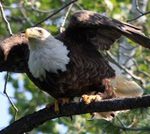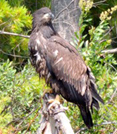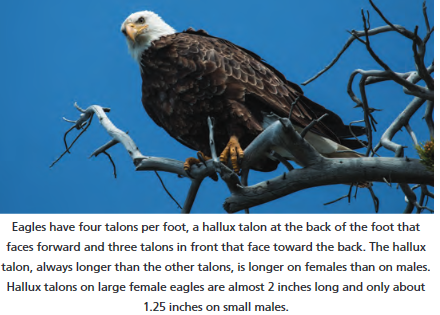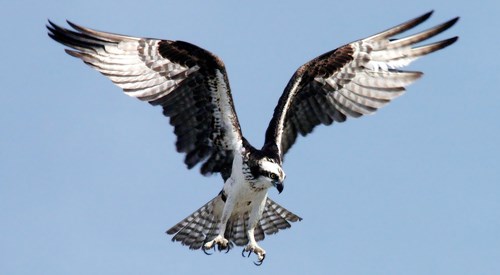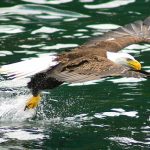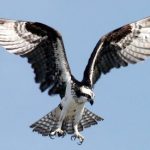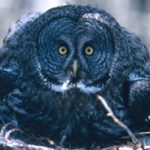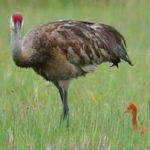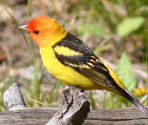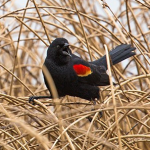We sat in our kayaks and canoes on Oxbow Bend in Grand Teton National Park and watched this eagle eating a fish for at least fifteen minutes one morning in 2003. No other people could have watched this from shore as we were in behind a couple of islands. Other birds were darting in and sometimes getting a few bits. (Two pictures below by Wendy Sato).
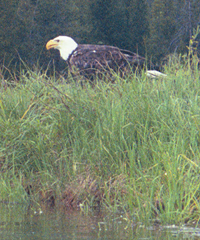
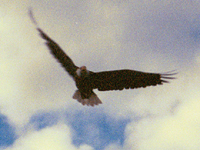
these pictures are from a video we shot:
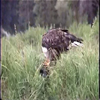
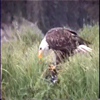
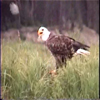

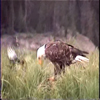
Was it the same eagle we saw the next year, while otters stole his fish?
Out on Oxbow Bend we saw a Bald Eagle on shore:

Without binoculars we could see otters climbing up the shore around the Eagle (look at shore edge to the left of the Eagle in the picture below). I thought, I bet he’s got a fish. Shortly the otters stole the fish from the eagle and he flew to a snag on another island across the water.

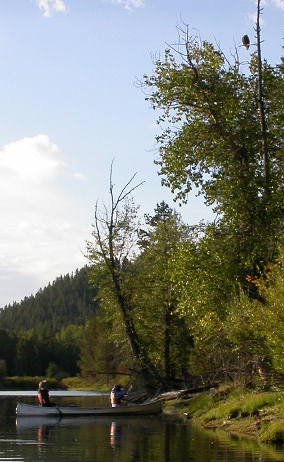
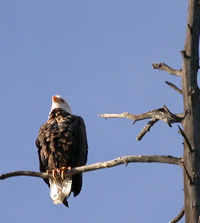
The otters swam around and ate the fish.
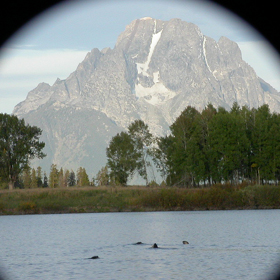
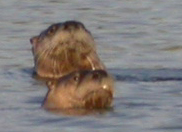
I saw a few cars stopped along the main road and people clustered looking out on the water. I looked with binoculars to see if they had spotted wildlife we had not, but it turned out they were watching us to see what we had found.
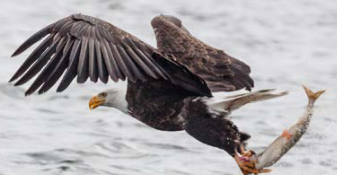
This next photo is courtesy of Tom Ingram Photography, all rights reserved tomingramphotography
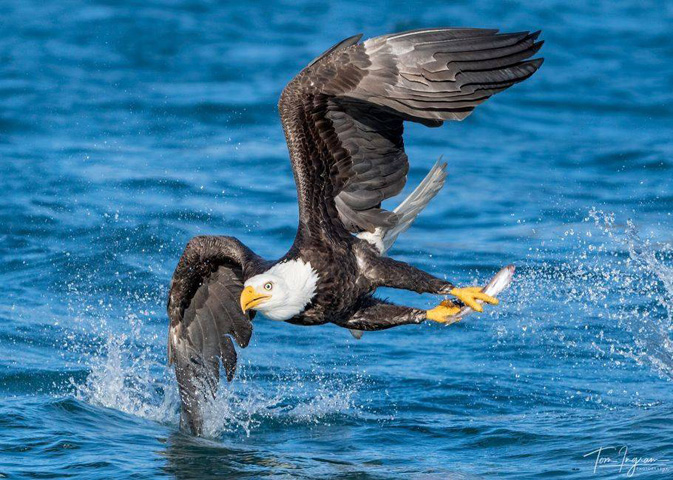
Eagles catch fish near the surface, by flying down at them and snatching them with their feet. The Bald Eagle can fly 20-40 mph in normal flight and when diving towards the water dive can reach speeds of 75 mph (one source says over 100 mph).
Along with fish caught swimming near the surface, eagles eat small mammals, waterfowl, and wading birds.
The National Park Service tells us that Bald Eagles:
“Feed primarily on fish and waterfowl, except in winter when fish stay deeper in water and lakes and rivers may be frozen. Then they eat more waterfowl. Eagles will also eat carrion in winter if it is available.
Form long-term pair bonds.
Some adults stay in Grand Teton and Yellowstone park year-round, while others return to their nesting sites by late winter.
Lays one to three eggs (usually two) from February to mid-April.
Both adults incubate the eggs, which hatch in 34 to 36 days.
At birth, young (eaglets) are immobile, downy, have their eyes open, and are completely dependent upon their parents for food.
Can fly from the nest at 10–14 weeks old.
Some young migrate in fall to western Oregon, California, and Washington.”
Their visual acuity is four to eight times greater than humans.
They nest in large trees close to the water, a few dozen in the Teton/Yellowstone area and may reuse the same nest year after year. Nests can be as big as 7 to 10 feet across, three feet deep and weighing almost a half ton. Sometimes they use the same nest year after year, adding more twigs and branches each season until the tree becomes unstable.
A record eagle nest, used for 34 years, weighed more than two tons.
Females are larger than males. The male dive bombs the female during their courtship flight, they meet in mid air, lock talons and plummet down, breaking out seemingly at the last second.
The bald in their name is not meant to mean featherless. It’s a derivation of balde, an Old English word meaning white.
NPS photos of adult and juvenile Bald Eagles:
The juvenile Bald Eagle above will not get white head feathers until it is about 4 or 5 years old.
Adult Bald Eagles have a wingspan of 6 to 7.5 feet (182cm-229cm).
They rarely flap their wings; they soar instead.
Hear a Bald Eagle (webpage labeled as a Golden Eagle, but when I linked to it, had Bald Eagle sounds, which include a piercing scream and various squawks / chirps .
Osprey, slightly smaller than the bald eagle, also hunt along the water, often in the vicinity of Bald Eagles:
Ospreys actually dive to catch fish rather than snatch them at the surface.
Ospreys also build large nests in the vicinity of water:
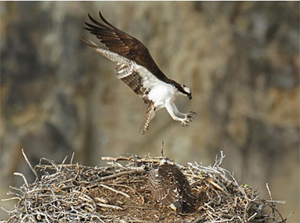
_________________________________
From an early June Tetons park news release about a road closure to protect a nest:
“Bald eagles mate for life and can live to age 30 in the wild. After breeding in late February, they lay from one to three eggs that hatch between late April and early June. Young eaglets begin to disperse from their nest site in late summer.
The bald eagle is protected by the Endangered Species Act, Migratory Bird Treaty Act, and the Lacey Act. Bald eagles were placed on the Threatened and Endangered Species list in 1978 as an endangered species, after their numbers dropped to fewer than 500 pairs. In 1995, they were upgraded to threatened status, as populations recovered from the brink of extinction.
Bald eagles are sensitive to a variety of human activities and may avoid areas where they encounter humans. They sometimes move away from people or even abandon nest areas, resulting in reproductive failure or the death of newly hatched eaglets. Even the cumulative effects of many seemingly insignificant activities may result in disruption of normal eagle behavior.
Although the bald eagle is making a gradual comeback, it is imperative that visitors give this rare and sensitive species the space it needs to survive. Local residents and park visitors can help reduce negative impacts to these nesting eagles by respecting the posted area closure. Violators of the temporary closure may be cited and fined.
The closure will be lifted by early to mid August, after the young eaglets fledge and are longer dependent upon the nest area.
___________________________________
Grand Teton National Park birds has photos and details about the most common ones we can hope to see
including Bald Eagle, Red-winged Blackbird, Canada Geese, Clark’s Nutcracker, Golden Eagle, Great Blue Heron. Great Gray Owl, Harlequin duck, Loon, Magpie, Merganser, Northern Flicker (woodpecker), Osprey, Ouzel, Pelican, Peregrine Falcon, Ptarmigan, Raven, Sandhill Cranes, Steller’s Jays, Trumpeter Swan , Western Meadowlark, and Western Tanager, with links to calls / songs from most of them to listen to.
and you can Download photos of over a hundred birds of Grand Teton National Park
https://www.audubon.org/climate/national-parks/grand-teton-national-park
___________________________________
People often get dangerously close to animals when they are trying to take a selfie.
Rocky Mountain mammal size comparisons has photos and comparisons of beavers, squirrels, pika, marmot, elk, moose, bison, fox, coyote, wolf, golden-mantled ground squirrel, chipmunk, Red Squirrel (also known as) Chickaree, Unita Ground squirrels, bobcat, lynx, mountain lion (cougar), pine marten, mountain goats, bighorn sheep, pronghorn, grizzly and black bears, tundra swan, trumpeter swan, osprey, adult and juvenile Bald Eagles.
Pictures and info about visitor centers, Cunningham Cabin, Menor’s Ferry, Chapel of the Transfiguration, Cascade Canyon, Signal Mountain summit road, Colter Bay Indian Arts Museum, Morman Row and the Wyoming Centennial Scenic Byway are at: Grand Tetons sightseeing
Grand Tetons September 2004 and Grand Tetons kayaking have more Oxbow Bend kayaking pictures.
The main trip information page is at Grand Tetons
Grand Tetons recommended reading has links to on-line bird and mammal field guides, as well as books to buy or check out from the library before the trip
Grand Teton and Yellowstone National Park photos
